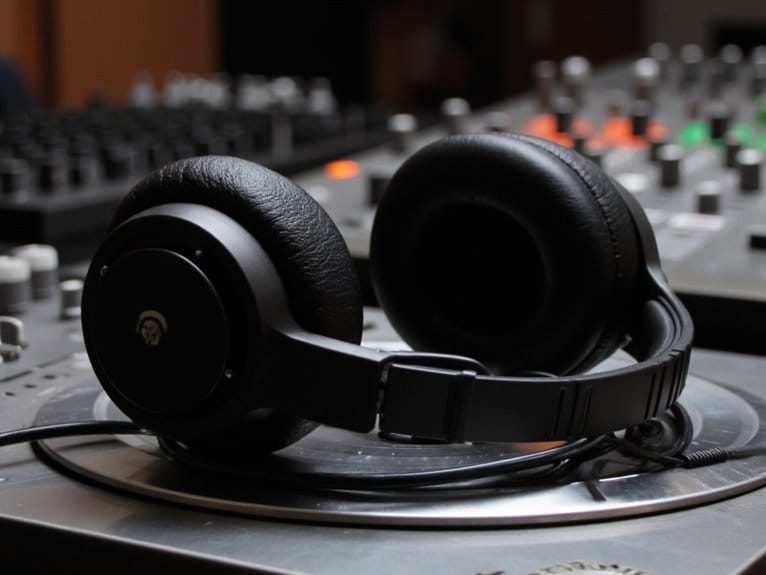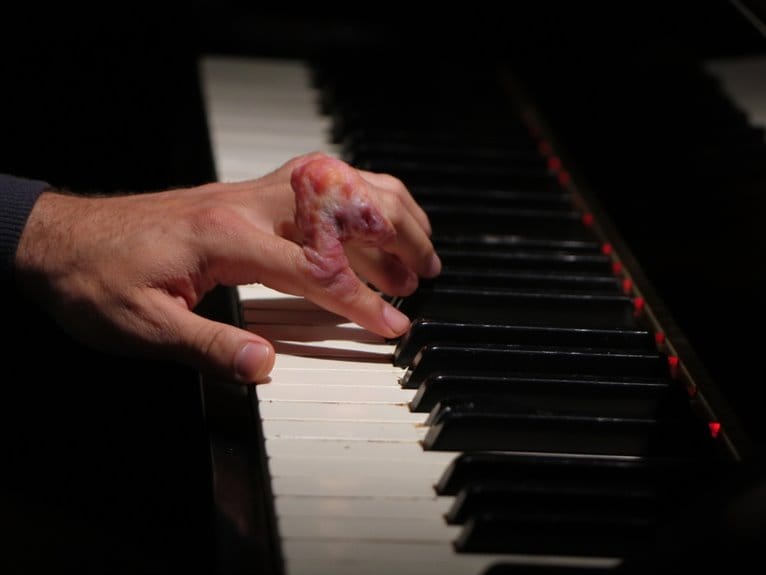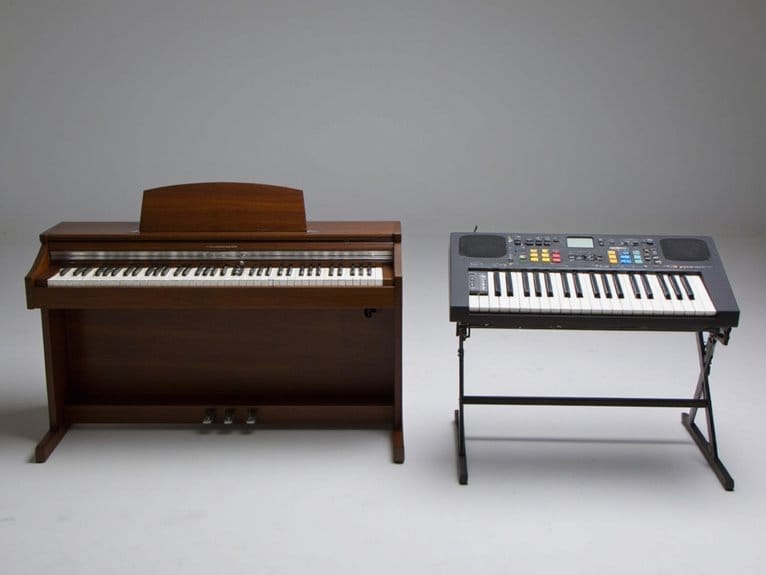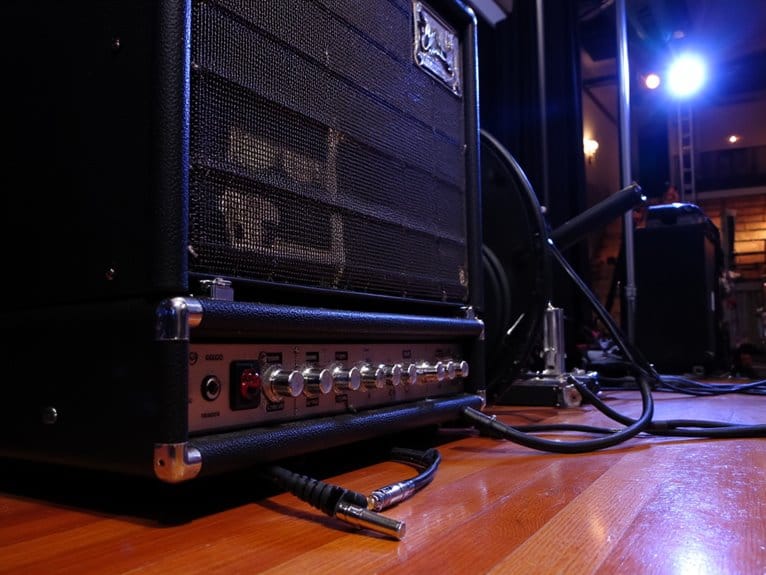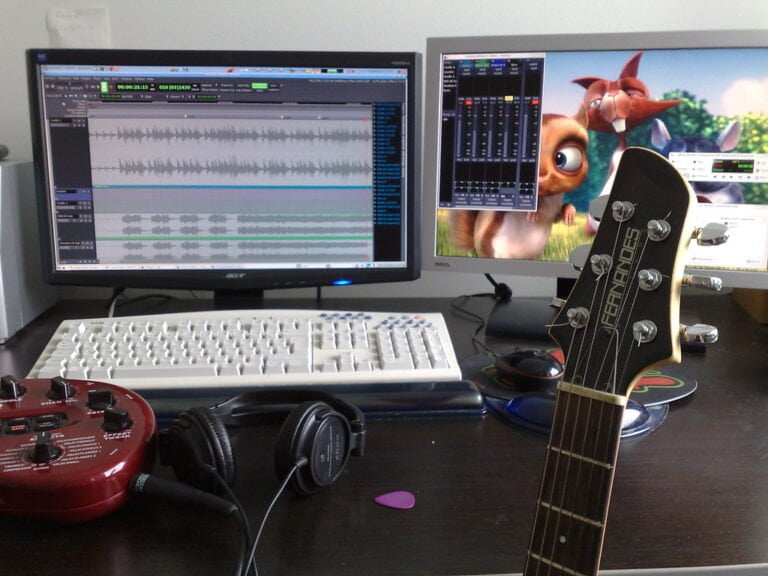Tom Configurations: Sizes and Tuning for Different Genres
You’ll want to match your tom configuration to your musical style, starting with jazz’s smaller 10″-12″ rack toms and 14″ floor toms tuned higher for crisp articulation, while rock demands 12″-14″ rack toms with 16″ floor toms tuned lower for powerful sustain. Metal players typically choose fewer, smaller toms with extremely low tuning and dampening, whereas shell depth directly affects your pitch range and resonance. Proper ergonomic positioning keeps rack toms centered at chest level with floor toms 4-8 inches from your knee, and there’s much more to explore about specialized configurations.
We are supported by our audience. When you purchase through links on our site, we may earn an affiliate commission, at no extra cost for you. Learn more.
Notable Insights
- Jazz drummers use smaller 10″-12″ rack toms with 14″ floor toms, tuned higher for resonant pitches with closer intervals.
- Rock configurations feature 12″-14″ rack toms and 16″ floor toms, tuned lower for powerful sustain and punchy sound.
- Metal players select fewer, smaller toms tuned extremely low with dampening to minimize overtones and create darker tones.
- Shell depth affects tuning range: deeper drums produce enhanced sustain, bass response, and fewer overtones.
- Larger tom diameters produce lower frequencies, with 16″ floor toms yielding 73-98 Hz versus 10″ toms at 147 Hz.
Standard Tom Dimensions and Shell Depth Variations κι
When you’re diving into the world of tom configurations, I’ve found that understanding standard dimensions serves as the foundation for everything else that follows.
Tom diameters typically range from 8″ to 20″, with rack toms spanning 6″ to 10″ depths and floor toms reaching 10″ to 18″ depths, though these specifications interact with drum material choices and manufacturing techniques in ways that’ll surprise you.
Historical trends show vintage drums featured shallower shells compared to modern designs, while depth impact directly affects your tuning range and sound resonance capabilities.
What’s particularly interesting is how mounting systems must accommodate these dimensional variations, and your aesthetic choices often determine whether you’ll prioritize the punchy attack of shallow shells or the fuller projection that deeper configurations provide. Larger shell diameters result in deeper tuning possibilities, which becomes especially important when configuring multi-tom setups. For precise measurements, you’ll need to remove the drum heads and hoops to get accurate diameter and depth readings.
How Tom Size Affects Pitch and Tonal Response
Three fundamental factors determine how your tom size translates into specific pitch and tonal characteristics, and I’ve discovered that understanding diameter’s relationship to frequency provides the clearest starting point for making informed decisions about your kit configuration.
Larger tom diameter produces lower pitch frequency ranges, with 16″ floor toms typically yielding fundamental tones around 73-98 Hz, while smaller 10″ toms reach approximately 147 Hz.
Shell volume profoundly impacts acoustic properties, as increased depth enhances sustain and creates fuller bass response. Deeper drums produce fewer overtones and deliver darker tonal qualities compared to their shallower counterparts.
Deeper tom shells generate richer low-end frequencies and extended sustain, fundamentally transforming your drum’s acoustic character and tonal depth.
I’ve found that resonant tuning between heads—maintaining 1.5 to 1.85 times the fundamental frequency ratio—maximizes harmonic overtones and tonal clarity, though this requires careful attention to pitch relationships across your entire kit setup. For jazz applications specifically, shell material significantly affects sustain and resonance characteristics, with hardwoods like maple and birch providing the warmth that complements the genre’s tonal requirements. When recording these tonal characteristics, condenser microphones excel at capturing the detailed frequency response and clarity that different tom sizes produce in studio environments.
Genre-Specific Tom Configurations and Sound Preferences
While diameter and depth provide the foundation for tom selection, I’ve learned that genre-specific preferences dramatically shape how drummers configure their kits.
These stylistic choices often override purely technical considerations in favor of musical context. Jazz drummers typically choose smaller 10″ and 12″ rack toms with 14″ floor toms, tuned higher for articulate, quick-decay sounds that won’t overpower subtle ensemble dynamics.
Rock configurations favor larger 12″-14″ rack toms with 16″ floor toms, tuned lower for powerful sustain that cuts through amplified instruments.
Metal players often select fewer, smaller toms tuned extremely low with dampening for tight, focused attack during rapid fills.
These genre comparisons reveal how tonal balance requirements fundamentally determine configuration choices beyond mere technical specifications. Modern recording setups benefit from wireless lavalier microphones positioned near toms to capture nuanced tonal differences without restricting drummer movement during performance.
Ergonomic Setup Considerations for Optimal Playability
Beyond selecting the right tom sizes and tuning for your musical style, the physical arrangement of these drums around your kit determines whether you’ll play comfortably for hours or develop aches that cut sessions short.
Mount your rack toms centered in front of your chest, keeping gaps small but preventing contact between drums, which maintains fluid movement without unnecessary reaching.
Position floor toms 4-8 inches from your knee, avoiding overextension that leads to spinal twisting during extended sessions.
Set your throne height so thighs remain parallel to the floor, supporting proper posture throughout performances.
Invest in ergonomic hardware with adjustable angles that let you fine-tune tom positions after initial placement, ensuring drumheads align naturally with your forearm angle while minimizing wrist strain during those marathon practice sessions.
Tuning Strategies Across Musical Styles
When you’re configuring your tom setup, the tuning strategy you choose fundamentally shapes your kit’s voice across different musical styles, with each genre demanding specific pitch intervals and harmonic relationships that complement its sonic characteristics.
I’ve found that rock and metal drummers typically favor lower, punchy tunings with wider intervals between toms to cut through dense guitar arrangements, while jazz players often opt for higher, more resonant pitches with closer intervals that provide smoother melodic shifts during fills.
Your genre-specific approach to tom tuning isn’t just about personal preference; it’s about understanding how pitch relationships interact with the harmonic content, dynamic range, and frequency spectrum that defines each musical style you’re supporting.
Genre-Specific Tuning Approaches
After years of experimenting with different tunings across various musical styles, I’ve discovered that each genre possesses its own distinct tuning DNA that shapes both the sound and playing approach in fundamental ways.
Folk tunings like DADGAD emphasize traditional roots through modal qualities, creating rich harmonic possibilities that complement fingerstyle techniques.
Blues resonances emerge from open G and E configurations, which facilitate expressive bending and slide work that standard tuning simply can’t match.
Grunge depth comes from whole-step-down approaches that enhance distortion sustain while reducing string tension.
Modal explorations across genres prioritize scale modes over conventional chord shapes, encouraging creative textures through drone effects.
Nashville shimmer adds brightness without altering familiar fingerings, while alternative chordings require complete re-learning of standard patterns.
Just as guitarists develop their sound through tuning experimentation, bass players benefit from understanding how split-coil pickups deliver the warm, versatile tones that complement these diverse musical approaches.
Pitch Interval Considerations
The foundation of effective tuning across different musical styles rests on understanding pitch intervals, those mathematical relationships between notes that determine whether your guitar sounds professionally tuned or like you’re torturing small animals.
I’ve found that developing perceptual sensitivity through interval training makes the difference between amateur and professional results, especially when working with harmonic ratios that define consonant intervals like perfect fifths and octaves.
Your ear develops through melodic dictation exercises and systematic tuning exercises that strengthen pitch recognition abilities, while acoustic feedback from your drums provides real-time validation of your adjustments. Professional drummers often employ double chain drives to achieve the precise responsiveness needed for complex rhythmic patterns that support these harmonic relationships.
This mathematical approach, combined with consistent practice, transforms what initially feels like guesswork into precise, confident tuning decisions that serve your musical goals effectively. Modern electronic drum sets offer extensive sound libraries that help drummers explore different tonal possibilities and develop their ear for proper pitch relationships across genres.
Just as guitarists rely on chorus effect pedals to add depth and richness to their tones across various musical genres, drummers can enhance their sound through strategic tom configurations that complement the harmonic content of different musical styles.
Specialized Tom Types for Advanced Applications
| Tom Type | Primary Application | Key Feature |
|---|---|---|
| Roto Toms | Progressive/Experimental | Pitch rotation |
| Concert Toms | Orchestral/Classical | Single-head resonance |
| Hybrid Toms | Electronic/Pop | Trigger integration |
Power toms design maximizes depth for aggressive rock and metal applications, while floor toms adjustments through specialized mounting systems guarantee ergonomic positioning across diverse performance environments.
Frequently Asked Questions
How Much Should I Budget for a Complete Tom Set Upgrade?
You should budget $500-$1500 for complete tom set upgrades, considering intermediate quality components. Budget considerations include heads, hardware, and shells, while tom set options range from basic replacements to professional-grade materials and electronic alternatives.
Which Drumhead Brands Work Best for Specific Tom Sizes and Genres?
You’ll find drumhead compatibility varies by tom size—Evans G1 works well for smaller toms while Remo Powerstroke suits larger ones. Your genre preferences matter too: jazz benefits from coated heads, rock needs double-ply durability.
How Often Should Tom Heads Be Replaced With Regular Playing?
You should replace tom heads every 6-12 months with regular playing to maintain head durability and tuning stability. If you’re performing frequently, consider replacement every 2 months for best sound quality.
On a final note
Your tom configuration journey doesn’t end with picking sizes—it’s about understanding how shell depth, tuning range, and genre demands interact to create your signature sound. Whether you’re chasing the punchy attack of shallow shells for rock or embracing deep, resonant tones for jazz, remember that ergonomic placement affects your performance as much as sonic choices. Experiment with different configurations, trust your ears, and don’t be afraid to break conventional setup rules.


